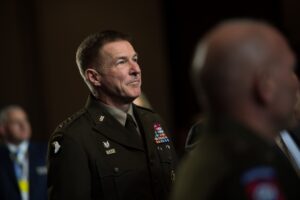The Army’s chief of staff said Thursday with “two or three more years of good, solid budgets,” along with keeping end strength flat and reducing the number of “exotic-type” exercises, the service believes it will be able to deliver results from across its modernization agenda.
“We don’t have the budget yet. But a lot of people are saying you shouldn’t anticipate having a much larger budget than you have, so what we’re doing is prioritizing what needs to get done,” Gen. James McConville said during a Brookings Institute discussion. “We’ve got some really good programs going. We probably need about two or three more years of good, solid budgets. And I think that’s something that we have to do.”

The Army is expected to detail its latest round of “night court” cuts when the FY ‘22 budget request is released, as it looks to shift billions more from lower priority programs over to its modernization efforts.
“We’re also taking a look at our legacy systems. You know, some systems we’re just not going to be able to continue to buy because we want to modernize the Army. Those are tough decisions and we’re aware of that, but we’re going to have to make those decisions in the future,” McConville said.
McConville reiterated that Army senior leadership remains committed to modernization and fully funding its more 30 signature systems, to include choosing to no longer grow end strength in the face of likely flat budgets in the coming years.
“I would have a bigger Army if I thought we could afford it. I think we need it, I really do,” McConville said. “I’ve already probably had to give up the growth we were going to have planned in the Army because if we do go flatline [in the budget]. That is kind of on the table right now. We’re probably not going to grow the Army more, even though I’d like to.”
There are currently around 485,000 troops in the regular Army, while McConville said he would want to grow that number to around 540,000 if the budget environment allowed.
On readiness, McConville said the Army can find additional savings if it relies on fewer “exotic-type exercises” and makes more economical training recommendations.
“You might be able to get the same type of training at the [Combat Training Centers]. You may not rotate the forces as much overseas. You might look at using our prepositioned stocks more forward rather than actually bring the whole system over there. So there are some things we can do to make our training more efficient and more effective,” McConville said.